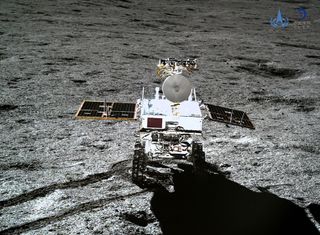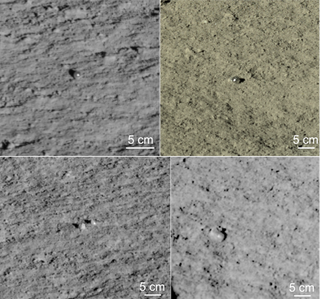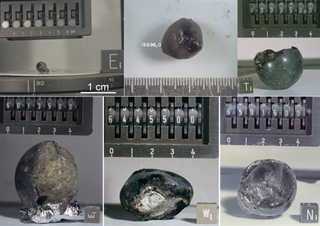China's moon rover spots 2 strange glass spheres on lunar far side
Still stranger, the glass is translucent.

China's Yutu 2 rover has made yet another curious discovery during its travels on the far side of the moon, this time turning up a pair of translucent glass globules.
The rover's panoramic camera spotted the two glass spheres as it drove across the surface of Von Kármán crater on the far side of the moon. The Apollo astronauts previously collected similar glass globules of about the same size, but those examples were mostly dark or opaque.
"The globules simply blow our mind, since they are so unique on the moon," Zhiyong Xiao, lead author of new research about the spheres and a planetary scientist at Sun Yat-sen University and the Chinese Academy of Sciences, said in a statement.
Related: China's Yutu 2 rover spots cube-shaped 'mystery hut' on far side of the moon
Xiao and his team believe the small spheres, which are between 0.59 and 0.79 inches (1.5 to 2.5 centimeters) across, were probably formed by relatively recent meteor impacts. Specifically, the researchers believe that the globules formed from anorthosite, a volcanically-formed rock rich in the mineral feldspar, after a high-energy impact melted the rock and reformed into spheres.
Xiao described the new finds as the "first discovery of macro-sized translucent glass globules on the moon." Finding these spheres on the moon suggests that impact events on the other planetary bodies could also form similar impact glasses, Xiao said. And on the moon, Xiao said that such glass spheres should be commonly produced by ancient impacts and could be valuable for understanding early lunar impact history.

Additionally, with countries now looking to establish lunar bases for long-term human stays, the anorthosites could be useful for astronauts looking to produce glass on the moon, meaning such material may not need to be transported from Earth. "Lunar anorthosites are excellent raw materials to manufacture glasses with good light-admitting quality," Xiao said.
Get the Space.com Newsletter
Breaking space news, the latest updates on rocket launches, skywatching events and more!
The researchers are limited in their analysis because they do not have data from Yutu 2's spectrometer, which could have provided greater insight into the composition of the glass globules. The rover imaged the objects but did not stop to focus its Visible and Near-Infrared Spectrometer (VNIS) instrument to collect reflected spectra.
The glass spheres are just the latest in a list of curious discoveries by Yutu 2. Others include impact melt glass, a "milestone," and a "mystery hut" on the horizon which turned out to be a rabbit-shaped rock.

Yutu 2 and the Chang'e 4 lander set down in Von Kármán crater in January 2019, making the first-ever landing on the far side of the moon. The pair's 40th lunar day was due to start following sunrise over their location on Feb. 23. Yutu 2 has covered more than 3,300 feet (1,000 meters) in total.
The research was published Feb. 26 in the journal Science Bulletin.
Follow us on Twitter @Spacedotcom and on Facebook.
Join our Space Forums to keep talking space on the latest missions, night sky and more! And if you have a news tip, correction or comment, let us know at: community@space.com.

Andrew is a freelance space journalist with a focus on reporting on China's rapidly growing space sector. He began writing for Space.com in 2019 and writes for SpaceNews, IEEE Spectrum, National Geographic, Sky & Telescope, New Scientist and others. Andrew first caught the space bug when, as a youngster, he saw Voyager images of other worlds in our solar system for the first time. Away from space, Andrew enjoys trail running in the forests of Finland. You can follow him on Twitter @AJ_FI.